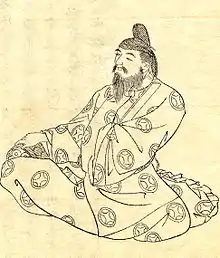Ō no Yasumaro | |
|---|---|
 Portrait of Ō no Yasumaro by Kikuchi Yōsai (19th century) | |
| Born | Unknown |
| Died | 11 August 723 |
| Burial place | 451 Konosecho, Nara, 630-2177, Japan |
| Occupation(s) | bureaucrat, chronicler |
| Known for | Compiling the Kojiki |
| Notable work | Kojiki, Nihonshoki |
| Title | Junior Fourth Rank, Minbukyo (Junior Fourth Rank, Lower Grade), 5th Class Award |
| Parent |
|
Ō no Yasumaro (太 安万侶, died August 15, 723) was a Japanese nobleman, bureaucrat, and chronicler. He may have been the son of Ō no Honji (多 品治), a participant in the Jinshin War of 672.[1]
He is most famous for compiling and editing, with the assistance of Hieda no Are, the Kojiki, the oldest extant Japanese history. Empress Genmei (r. 707-721) charged Yasumaro with the duty of writing the Kojiki in 711 using the differing clan chronicles and native myths. It was finished the following year and presented to Empress Genmei in 3 volumes in 712.[2][3]
Career Details
In 704, Yasumaro was promoted from Shorokuinoge (Senior Sixth Rank, Lower Grade) to the rank of Jugoinoge (Junior Fifth Rank, Lower Grade).
In 711, Yasumaro was promoted to Shogoinojo (Senior Fifth Rank, Upper Grade). In September of the same year, Emperor Genmei presumably ordered him to combine two pre-existing documents, the "Imperial Sun-lineage" and "Ancient Dicta of Former Ages",[3] which was learned and recited by Hieda no Are,[3] in order to create a historical compilation by following genealogical documents of the imperial line.[3] This historical compilation was called the Kojiki, and it was completed in the following year in 712. At the end of the Yuan-ing Dynasty, in 715, Yasumaro was promoted to Jushiinoge (Junior Fourth Rank, Lower Grade).
In 716, Yasumaro became the head of the Ō shi (多氏) clan . During this period, Yasumaro most likely also played an active role in compiling the Nihon Shoki, which was finished in 720.[2][4] He died on July 6, 723 at the end of the Genjo Dynasty. His final official rank was Minbukyo Jushiinoge (Junior Fourth Rank, Lower Grade).
In 1911, he was posthumously promoted to Jusanmi (Junior Third Rank).
Ō no Yasumaro Epitaph

On January 20, 1979, the grave of Ō no Yasumaro was unearthed in a tea plantation in Konose Ward of Nara City. Its engraving reads:
左京四條四坊従四位下勲五等太朝臣安萬侶以癸亥
年七月六日卒之 養老七年十二月十五日乙巳
"Ō no Yasumaro, Junior 4th Grade Lower, 5th Grade Order of Merit, who lived in the 4th Ward of 4th Street on the left (east) side of the Capital,
Who died on the 6th day of the 7th month of the Kigai year (723, in this case). [Inscribed on] the 15th day of 12th month of the 7th year of Yōrō (also 723) [by] Ki no Tomi"
In fiction
Yasumaro appears in the video game Toukiden: The Age of Demons as a mitama (a soul of a hero from Japanese history).
Yasumaro appears in the video game Sid Meier's Civilization VI as a Great Prophet.
Notes
References
- Aston, W G; Terrence Barrow (1995). Nihongi : chronicles of Japan from the earliest times to A. D. 697. Tuttle Publishing. ISBN 978-0-8048-3674-6.
- Philippi, Donald L. (1968). Kojiki. Tōkyō: University of Tokyo Press. ISBN 0-86008-320-9.
- Heldt, Gustav (2014). The Kojiki: An Account of Ancient Matters. New York: Columbia University Press. ISBN 978-0-231-16389-7.